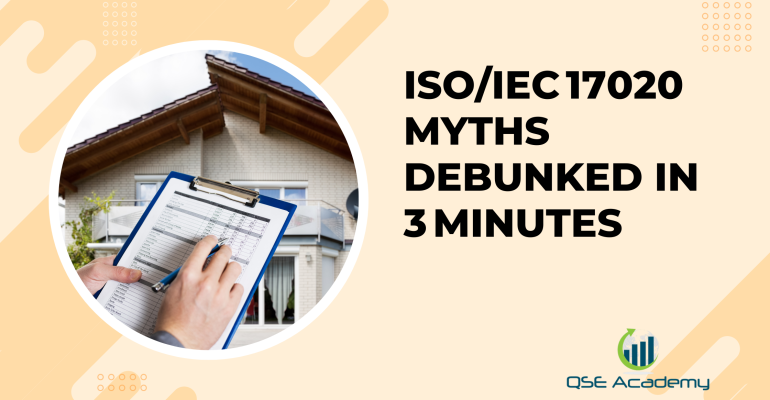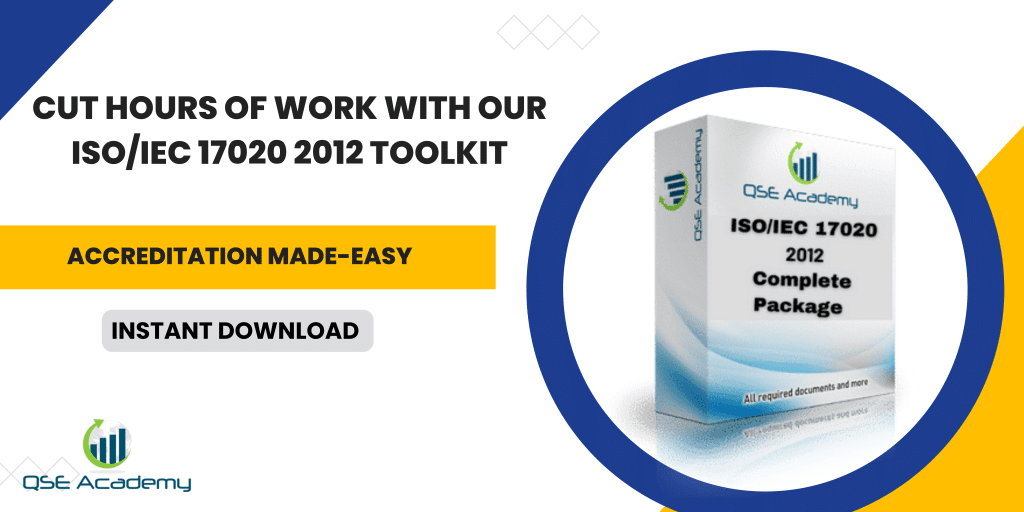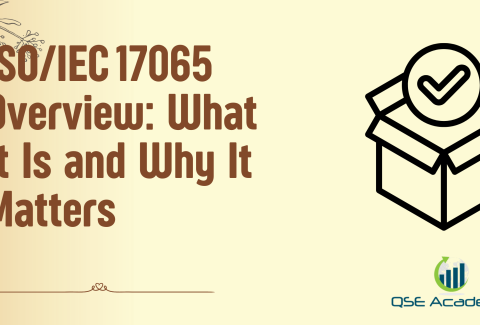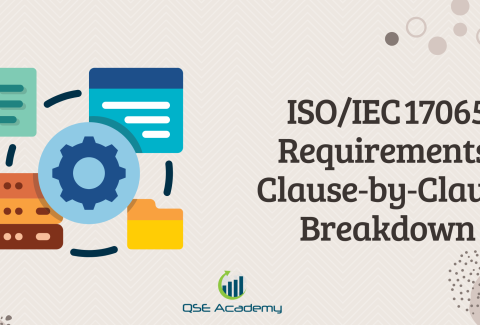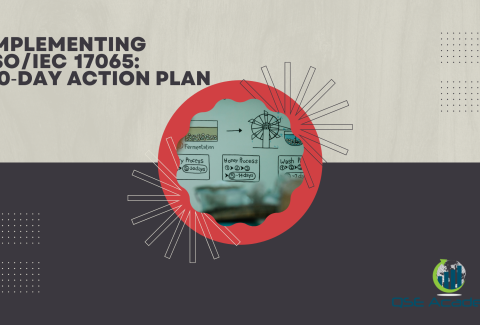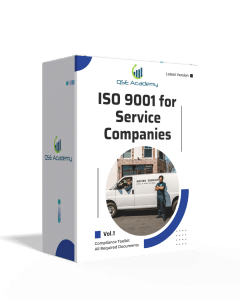ISO/IEC 17020 Myths Debunked in 3 Minutes
Last Updated on October 22, 2025 by Hafsa J.
Why So Many Myths Exist About ISO/IEC 17020
If you’ve been researching ISO/IEC 17020 accreditation, you’ve probably come across a lot of confusing or flat-out wrong information.
Some say it’s only for large inspection companies. Others claim you need a laboratory to qualify. And many think it’s just another version of ISO 9001.
I’ve heard these same statements from inspection managers, consultants, even auditors — and they all have one thing in common: they slow organizations down.
Teams waste months preparing the wrong documentation, chasing unnecessary requirements, or assuming accreditation isn’t worth the effort.
Here’s the reality: ISO/IEC 17020 is one of the most flexible and scalable accreditation standards out there. It’s designed to fit everything from a two-person inspection startup to a government regulatory agency. Yet myths about it keep circulating because most people never see how the standard actually works in practice.
In this article, I’ll clear up the most common misconceptions — quickly.
In just a few minutes, you’ll learn what’s true, what’s not, and how to approach accreditation with confidence instead of hesitation.
Let’s start by addressing the first big misunderstanding: the idea that ISO/IEC 17020 is only for large inspection bodies.
Myth #1 – “ISO/IEC 17020 Is Only for Big Companies”
This is the most common misconception — and it’s completely false.
ISO/IEC 17020 was designed to be scalable, which means it applies just as well to a small, two-person inspection firm as it does to a multinational organization.
Accreditation isn’t about company size — it’s about competence, impartiality, and consistency.
I’ve seen small inspection startups outperform large corporations during assessments simply because they had clear procedures, proper records, and a well-trained team.
What matters to accreditation bodies isn’t how big you are, but how well your system works.
Scalability in Practice
| Factor | Small Inspection Body | Large Inspection Organization |
|---|---|---|
| Documentation | Streamlined manuals and procedures covering all activities; one person may wear multiple roles. | Detailed procedures, department-specific manuals, multi-level review structure. |
| Resources | Limited but well-documented tools and evidence of calibration or verification. | Extensive equipment control systems and databases. |
| Personnel | A few trained inspectors who perform and review inspections. | Several teams with defined authorizations and competence hierarchies. |
| Impartiality Controls | Separation of duties through role definition. | Committees or formal impartiality boards. |
| Accreditation Scope | Narrow, focused on a defined service area. | Broad, covering multiple technical fields. |
Both setups can fully comply with ISO/IEC 17020 — as long as they demonstrate impartiality, technical competence, and proper control of activities.
Key Insight
Accreditation isn’t a luxury for big firms — it’s a credibility tool for any inspection body.
For smaller organizations, it’s often a way to compete on equal footing with larger players, proving technical reliability without needing massive resources.
Myth #2 – “ISO/IEC 17020 Is the Same as ISO 9001”
This myth spreads quickly because both standards include management system requirements — but that’s where the similarity ends.
While ISO 9001 focuses on quality management and customer satisfaction, ISO/IEC 17020 focuses on technical competence and impartiality in inspection activities.
You can have a great ISO 9001 system and still fail ISO/IEC 17020 — because the two aim to prove very different things.
How the Two Standards Differ
| Aspect | ISO 9001 | ISO/IEC 17020 |
|---|---|---|
| Purpose | To ensure organizations consistently deliver quality services or products. | To ensure inspection results are impartial, technically valid, and traceable. |
| Focus | Management consistency, continual improvement, and customer satisfaction. | Technical competence, inspector qualification, and independence. |
| Outcome | Certification by a registrar (quality system compliance). | Accreditation by an official body (technical credibility). |
| Core Evidence | Policies, objectives, and customer feedback. | Inspection procedures, calibration records, inspector authorizations, and impartiality proofs. |
| Recognition | Widely accepted in general business sectors. | Required in regulated industries and conformity assessment. |
Why This Distinction Matters
If you already have ISO 9001, that’s a great foundation — it means you understand documentation, audits, and improvement cycles.
But ISO/IEC 17020 takes those principles and applies them in a technically specific way. It requires you to prove that your inspection outcomes are competent, impartial, and defensible.
You can think of it this way:
-
ISO 9001 tells clients, “We manage our quality well.”
-
ISO/IEC 17020 tells regulators, “You can legally and technically rely on our inspection results.”
Both are valuable, but only one — ISO/IEC 17020 — makes your inspection reports recognized and authoritative under international accreditation rules.
Key Insight
ISO 9001 builds management confidence.
ISO/IEC 17020 builds public and regulatory trust.
Understanding that difference helps inspection bodies prepare the right way — focusing on competence, not just paperwork.
Myth #3 – “You Need a Laboratory or Test Facility to Qualify”
Many organizations assume ISO/IEC 17020 accreditation is only for companies that run laboratories or perform physical testing — but that’s not true.
The standard applies to inspection activities, not testing or calibration.
Inspection bodies don’t need to measure data in a lab; they need to observe, verify, and judge whether something conforms to defined requirements.
This myth often comes from confusing ISO/IEC 17020 with ISO/IEC 17025 (the laboratory standard). The two are part of the same conformity assessment family, but their roles are completely different.
Inspection vs. Testing – The Core Difference
| Activity Type | Description | Applicable Standard | Output |
|---|---|---|---|
| Inspection | Examination of a product, process, service, or installation to determine conformity with requirements (visual, functional, or documentary). | ISO/IEC 17020 | Inspection report or certificate of conformity. |
| Testing | Determination of one or more characteristics of an item according to a defined procedure or method. | ISO/IEC 17025 | Test or calibration report with measurement results. |
In simple terms:
-
If you judge compliance, you belong under ISO/IEC 17020.
-
If you measure values, you belong under ISO/IEC 17025.
Examples of 17020-Applicable Inspections
| Sector | Example Inspection Activity | Why It Falls Under ISO/IEC 17020 |
|---|---|---|
| Construction | Visual inspection of welds or structural integrity. | Relies on observation and criteria judgment, not measurement. |
| Manufacturing | Product conformity checks against design drawings. | Evaluates compliance, not numeric test data. |
| Transportation | Vehicle safety or emissions inspections. | Applies pass/fail criteria based on regulatory limits. |
| Energy | Pressure vessel or pipeline integrity assessments. | Observes compliance with codes and maintenance records. |
None of these require laboratories — they require competent inspectors, clear procedures, and documented impartiality.
Key Insight
ISO/IEC 17020 accreditation recognizes inspection expertise, not laboratory capacity.
If your organization evaluates compliance — even visually or through documentation — you qualify.
The real question isn’t “Do we test?” but “Do we inspect, verify, or decide conformity?”

